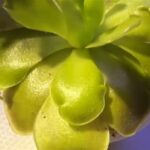As an Amazon Associate, this site earns commissions from qualifying purchases. For more details, click here.
Pinguicula caerulea is found throughout the warmer areas of the United States and it is classified as a warm temperate butterwort. The plant is known for its beautiful blue flowers which has earned it the name blue butterworts. In the following guide you will learn the essentials for growing these plants.
Pinguicula caerulea can be grown in garden bogs or greenhouses with filtered sunlight. This warm temperate butterwort cannot survive winter freeze and must be in mild temperature, preferably 65-75 F.
| Soil | 1:1 peat and silica |
| Water | Keep soil moist, use purified or distilled water |
| Light | Full or partially shaded |
| Food | Small bugs, bloodworms, mealworms, fish betta pellets |
| Temperature | 65-75 F (18-25 C) |
| Humidity | 50% |
| Dormancy | No |
| Propagation | Leaf pullings |
Soil
There are many potting soil options, but the most widely used is 50/50 silica sand and peat. You can add a bit of vermiculite to the mix or try 70/30 river sand and peat. Others prefer to add live sphagnum instead and reduce the peat.
The soil should be moist but not too damp. In general p. caerulea soil needs less water compared to other warm temperate butterworts. If the soil is too damp it will damage the roots and may require repotting to save it.
If you are not sure what media to use, do not worry. P. caerulea sold online can be purchased with ready to use soil so you do not need to do mixing. All you need to do is water the plant, provide light and food, and your butterworts will grow.
If you are not happy with the result – or just want to experiment- try peat and perlite or other types of poor nutrient media. Do this only if you have experience as using the wrong soil mix will seriously affect the plant.
Pot Container
A 3 inch pot is large enough for pinguicula caerulea. These plants rarely need repotting so one should be enough. At any rate, pots are cheap so you can buy another in case the need arises.
P. caerulea is sold with or without a pot. This is usually the case with other butterworts including pinguicula rectifolia and others. If it comes with a pot and soil, all you have to do is find a sunny location for it.
If the plant is not potted, buy any 3 inch container and potting media. Prepare the soil according to the instructions, water it lightly and plant your p. caerulea.
The only instances you may need to repot is if the plant is sick, the pot is damaged or the soil been contaminated. Root rot and insect infestation are other reasons to repot.
All you have to do is hold the plant with one hand then turn the pot upside down. Shake the container until all the soil has fallen out. Prepare new soil and pour it into the new pot. Plant your pinguicula and place it under full sunlight. Water right away to help the plant recover from the process.
Water
Pinguicula caerulea should be watered from the top. Keep the soil damp constantly and never use tap water. Use mineral free water, distilled or reverse osmosis.
While p. caerulea needs moist soil, it should not be too soaked. This plant grows in the warmer regions of the northern hemisphere so avoid too much water.
There are exceptions to the rule. Some people have been able to grow p. caerulea in a wet pumice and peat mix. If your ping is healthy it can handle wet conditions, but as a rule the soil should never be too damp.
Water from the top until the soil is moist. Repeat when the media starts to dry. If you live in a very dry area with temperatures above 85 F, you may use the tray method. Pour just one inch of water and refill if necessary.
Light
You can grow pinguicula caerulea in an outdoor garden bog, a greenhouse or a terrarium. The plant needs partially shaded or full sunlight. Indoor lights may also be used.
A lot of butterworts such as pinguicula sethos thrive in partial or full light under the right conditions. By the right conditions that means the ideal temperature, humidity, water etc. Pinguicula that grows in an ideal environment will be able to handle a lot more sun.
Outdoors. Find a sunny location or raise the plant in a garden bog. Full morning light is the best, while midday and afternoon light may be too harsh. Remember that p. caerulea does not go dormant so do not leave it outdoors during winter.
Indoors. Set the plant on a windowsill, the more sunlight the better. If the heat level goes up, move the pot away from the window.
Artificial lights. Since these plants do not have dormancy, you may have to use artificial lights in winter. Warm LED or fluorescent lights are suitable for p. caerulea and other warm temperate butterworts. The iPower Dual LED Grow Light should work nicely here.
Temperature
Warm temperate butterworts such as p. caerulea prefer mild weather. You can keep the plant in 65-75 F (18-25 C) throughout the year.
Maintaining the temperature is easier if the plant is indoors. You can cultivate this ping in a greenhouse or terrarium as well. If the plant is outdoors, make sure it gets enough light without being sunburned.
For beginners it is easier to grow p. caerulea inside. A room thermometer will tell you if it is getting too hot or too cold. If the plant is getting sunburned, move it away from the window until the temperature cools down.
Humidity
A humidity rate of 50% is enough for these plants. Unlike other pings, they do not need a high humidity level to stay healthy. Too much cold and moisture can be harmful to these plants.
As long as the temperature is around 65-75 F (18-25 C) it is acceptable. Healthy warm temperate pinguicula can and do grow in higher or lower humidity levels. What you need to do is focus on the other variables like temperature, water and sunlight. If these requirements are met you can feel confident the humidity level will be sufficient.
As was pointed out earlier, pinguicula roots are prone to rot. This can happen if the plant is over watered and humidity is too high. This can be fatal to butterworts so you have to avoid this at all costs.
Nutrition and Feeding
A pinguicula caerulea feeds on mostly small insects. Feeding every couple of weeks is enough and some pings are fed just every three weeks.
Even if the plant is indoors it should still catch the occasional housefly or mosquito. You may give it bits of fish beta pellets or better yet, TetraCichlid Crisps if you think it is not receiving enough nutrients.
If your ping is in a terrarium you have to feed it regularly. Just scatter a few bits of food onto its leaves. No need to feed each leaf, just a couple is enough.
If your pinguicula blooms, produces sticky leaves and has bright colors, then it is getting enough nutrients. If the plant looks unhealthy, increase the humidity by watering more often. Give it a few weeks and your plant should recover and start eating more food.
Do not fertilize the soil, but some use a small amount of fertilizer as food. There is a detailed guide on how to fertilize pinguicula if you are interested. But remember that this should only be used on the leaves, not the soil.
Dormancy
Pinguicula caerulea does not need dormancy. This is one of the few pings that retains its leaves regardless of the season. So you have to keep the plant in the same environment so it keeps growing.
With most butterworts, there is a growth and rest season. During the rest period the plant slows down and requires less water, light and does not eat. That is not the case with p. caerulea. The plant might slow a little, but most of the time it will retain its leaves.
This plant cannot handle winter frost so move it indoors before the cold season. Even better, just keep p. caerulea indoors all the time. The light on a windowsill will be enough.

My fascination with carnivorous plants began many, many years ago with Venus Fly Traps. Now I am more than happy to impart what I know with other enthusiasts and those who are curious about meat eating plants.



